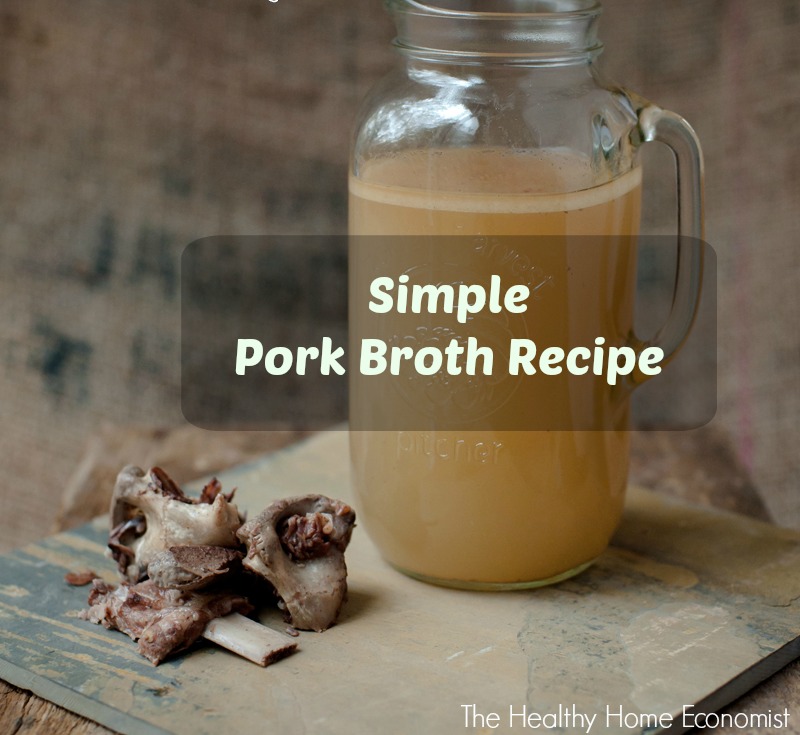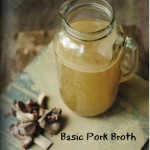 Making homemade bone broth is a crucial technique a Traditional Cook must master. Ideally, it is made at least once a week. Since quality bones are expensive, is pork broth an option? Most people have never considered it. Quality pastured pork at affordable prices is widely available in many communities. Let’s examine this question below.
Making homemade bone broth is a crucial technique a Traditional Cook must master. Ideally, it is made at least once a week. Since quality bones are expensive, is pork broth an option? Most people have never considered it. Quality pastured pork at affordable prices is widely available in many communities. Let’s examine this question below.
Health Requires Lots of Bone Broth – Why Not Pork?
I make a large pot of stock once or twice every week. Our family flies through quarts of it so quickly at mealtimes! A ready supply of gelatin and mineral rich broth in the freezer is also important when illness strikes. This nutrient rich food is a key player for rapid recovery without meds. This is especially true when a fever is involved.
Commercial Broth vs Homemade Broth
Getting sick and realizing there is no homemade bone broth is a devastating feeling, I can assure you! Simply running out to the store to pick up some canned soup or broth in a carton is not going to solve the problem. These industrially produced products even if organic are just water and MSG with little to no nutrient value and certainly no gelatin!
Even the properly made commercial bone broths available in recent years are not comparable to homemade. They are all watered down (every single brand I’ve tested). What’s worse, they are usually packaged in toxic plastic or plastic lined tetrapaks. The broth is boiling hot when it is poured into the containers if the product is shelf stable. Try it yourself. Put them in the refrigerator. They don’t gel like broth made at home does. The only brand worth buying is Epic bone broth in glass jars, but unfortunately it is still watered down.
Making your own broth has no substitute!
There is nothing worse than a tummy bug striking your children and knowing that a pot of gelatin rich stock that will halt the illness in its tracks is a full 24-48 hours away. Unless, of course, you can quickly source the right kind of fishheads, then a pot of stock can be ready in as little as 4 hours.
Pork Broth More Affordable than Most
With plenty of stock on hand for whatever your cooking or wellness needs might be, the next question is how to source quality bones at a price that is within a typical family’s food budget.
The highest quality pastured pork bones for making pork stock tend to cost between one half and three quarters as much as grassfed beef bones or pastured chicken in my experience, particularly if you source an entire hog.
Some might question how pork bones could make good pork broth given the fattiness of the meat. Culinary purists believe that soups and sauces made with fatty stock do not yield the best results. This problem is easily remedied by chilling pork stock in the refrigerator which allows the congealed pork fat to be removed from the top of the container of stock with a spoon.
If you’ve never tried pork broth or pork stock before, why don’t you give it a try? Here is a very simple and basic pork broth recipe to get you going. It is inspired by the beautiful book Beyond Bacon, Paleo Recipes that Respect the Whole Hog, by Stacy Toth and Matthew McCarry.
How to Make Pork Broth (Pork Stock)
The recipe for pork stock below makes about 2 quarts. Try it with your next batch! I’m sure you’re going to love it!


Pork Broth Recipe
How to make pork broth that is a affordable, nutritious, and delicious alternative to other more expensive stocks made with pastured poultry or grassfed beef bones.
Ingredients
- 3 lbs pastured pork bones
- 1 Tbl apple cider vinegar raw and unfiltered, preferably organic
- ground peppercorns
- sea salt
Instructions
-
Put all of the bones in a stockpot and add enough filtered water to cover.
Cook on high until the water comes to a boil and scum rises to the top. Cook for 5 minutes.
Dump the entire pot of water and refill with fresh filtered water, enough to cover the bones. Mix in the apple cider vinegar and bring the water to a boil once again.
Carefully skim off any foam that comes to the top. It should be minimal given that the water with most of the scum was dumped in the previous step.
Reduce heat and simmer on low for 9-24 hours.
Remove the pot from the heat, strain and taste. Add salt and pepper as needed. Let cool and then refrigerate in one or more airtight containers.
Skim the lard off the top of the chilled pork broth the following day and refrigerate. Reserve this delicious fat high in Vitamin D for cooking. This article plus video provides more information on how to render lard.
Use the clarified pork stock as the base for soups and sauces the same as you would use chicken or beef stock.
Sarah, The Healthy Home Economist








Iuse whatever pork bones I can afford. I also save any bones from pork chops we eat. I follow the same steps as above, except I also add 1 onion, 3 stalks of celery, a couple cloves of garlic, and 2 or 3 carrots. It makes the broth so much more flavorful. I actually prefer pork broth to any other.
Are there some pig bones that are better for broth than others? I was at a church having a pig roast/potluck and scored a huge pan of bones for free. I made one batch in the slow cooker and the broth doesn’t taste that great. Haven’t cooled it yet to know if it is going to gel.
Thanks on your marvelous posting! I quite enjoyed reading it, you happen to be a great author.I will be sure to
bookmark your blog and will eventually come back sometime soon.
I want to encourage one to continue your great work, have
a nice afternoon!
I see that there are lots of comments about pressure cookers here. Even with the number of people growing that are using them because of the research that shows that they are safe and even healthier, I still fill very hesitant to start using one. Sarah, I know that you have mentioned that the high heat creates glutamates. I am wondering if you can provide some research or more detailed information so that I may feel more confident in my choice not to use a pressure cooker. Thanks so much!
Hi Tina, I don’t know of any research on the subject and for that reason have not started using one. The existing research on pressure cookers does not sufficiently answer this question for me. I am quite happy using a stock pot.
from nourishingbroth.com
Question:
Is there nutrient loss from using a pressure cooker?
I have been using a pressure cooker recently to make bone broth. I usually cook it 5 hrs. Am I losing nutrients because of the heat? I will go back to regular 8-24 hr cooking if I am. Thank you
ANSWER:
Neither Sally nor I use a pressure cooker, but we know many people who love them. Pressure cookers seem to help achieve the gelatin we value so much. In terms of nutritional value, we have not done comparison testing of pressure cooker broth vs stockpot vs slow cooker. We’d love to do lab testing for a long lists of nutrients, but that gets very expensive very fast. If you know anyone who’d like to give us about $20,000 for a small study, we’d like to move forward with that testing. In the meantime, I see no reason for you to stop using your pressure cooker. However, we do question pressure cooking for 5 hours. I think most recipes say 1 hour though I’ve seen some recipes that recommend up to 3 hours. However you make it, enjoy your broth and be souper!
Yes … exactly. Until further study is done, I will stick with the tried and true stockpot over a pressure cooker.
What is this article, 30 years old? modern electric pressure cookers don’t explode. They’re very safe.
I don’t know about 2 hours. I make rich chicken stock in 30 minutes
Rich chicken stock in 30 minutes loaded with MSG. There is always a price to pay for speed. No thanks.
How does using a pressure cooker add MSG???
The unnaturally high pressure creates glutamates (denatures some of the protein).
Does using a pressure cooker always cause glutamates or just when you pressure cook meats? I just bought one to cook beans faster.
Probably since it cooks with unnaturally high pressure every single batch.
I actually looked this up and found that pressure cooking has been found, in numerous studies, to be one of the /healthiest/ ways to cook food. Please note that the following is all information I have found out within the past 4-ish hours of reading various articles on pressure cooking
Denaturing proteins is the primary purpose of ALL cooking, whether over a campfire or in an oven (Or other way of cooking), because this denaturing makes it easier for our bodies to absorb the proteins.
Because cooking times are shorter, vitamins have less time to leech out of the food. Additionally, because the steam is kept trapped, if you let the pressure cooker cool before opening it, the steam will condense back into water and take the vitamins with it back into a handy pool of water in the pot.
Also, you are factually incorrect. There is no such thing as “glutamates”. Monosodium Glutamate is (chemically) a salt of Glutamic Acid. From the Wikipedia page on Glutamic Acid: “The substance was discovered and identified in the year 1866, by the German chemist Karl Heinrich Ritthausen who treated wheat gluten (for which it was named) with sulfuric acid.”
I respect that you have more experience than I do regarding cooking, but multiple sources, along with scientific studies, disagree with your assertions on this particular point.
Here’s one of the best articles I’ve found, almost completely textual:
foodrenegade.com/pressure-cooking-healthy/
Have at it! I’m not convinced and won’t be using a pressure cooker anytime soon 🙂
Any suggestions for using the broth? I have quarts of it, a little over zealous :). Also how do you give it for illnesses? my kiddos are bummed just looking at the texture, nevermind ingesting pure like that. Thanks!
You can warm it on the stove, add a bit of salt and serve like a cup of tea. Or, you can use as a base for soups and sauces … many recipes for these on this blog 🙂
I’m using it in a recipe for milk-braised pork shoulder. Had it at a restaurant and it was wonderful. Recipe calls for 2 gallons so I am going to be making my own pork stock and freezing the rest for soup or another braise later!
Do I leave it covered or uncovered while simmering?
Covered.
Firstly time I see someone recommending covering a stock while simmering.
Hello, I just found your blog scrolling through Pinterest trying to find pork stock recipes. I have Ham bone from Thanksgiving and wanted to try and make a pork stock for my Udon soup. Is it ok to use the bones from a Thanksgiving ham? I don’t know if it’s pasteurized or not and right not with our financial situation do not care, we are just trying to make it all stretch. My only concern is flavor, will I achieve a good enough stock for the soup with the Ham bones. Thanks in advance.
What type of fish heads should we get to be able to make fish broth in 4 hours? Thanks.
I made this yesterday. The broth is SO gelled. The best gel I’ve ever gotten. I had a HUGE pkg of bone in pork loin (24 pounds) in the freezer. I’d gotten it on sale for .99 a pound. It was SUPPOSED to be repackaged into smaller portions but hubby put it in the freezer as it was. I FINALLY pulled it out, determined to deal with it somehow. I cut all the bones out, put them in a big pot and followed the instructions above. It is VERY flavorless but that’s OK because I can now use it as a base for anything. There was quite a bit of meat that came off the bones so the broth has the leftover meat in it, also. Not sure yet what I’m going to do with it but I’ve got 3 quarts of broth/meat in the freezer.